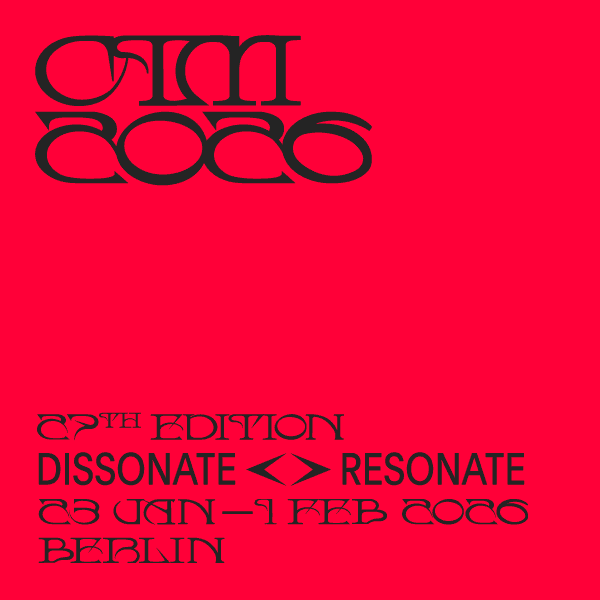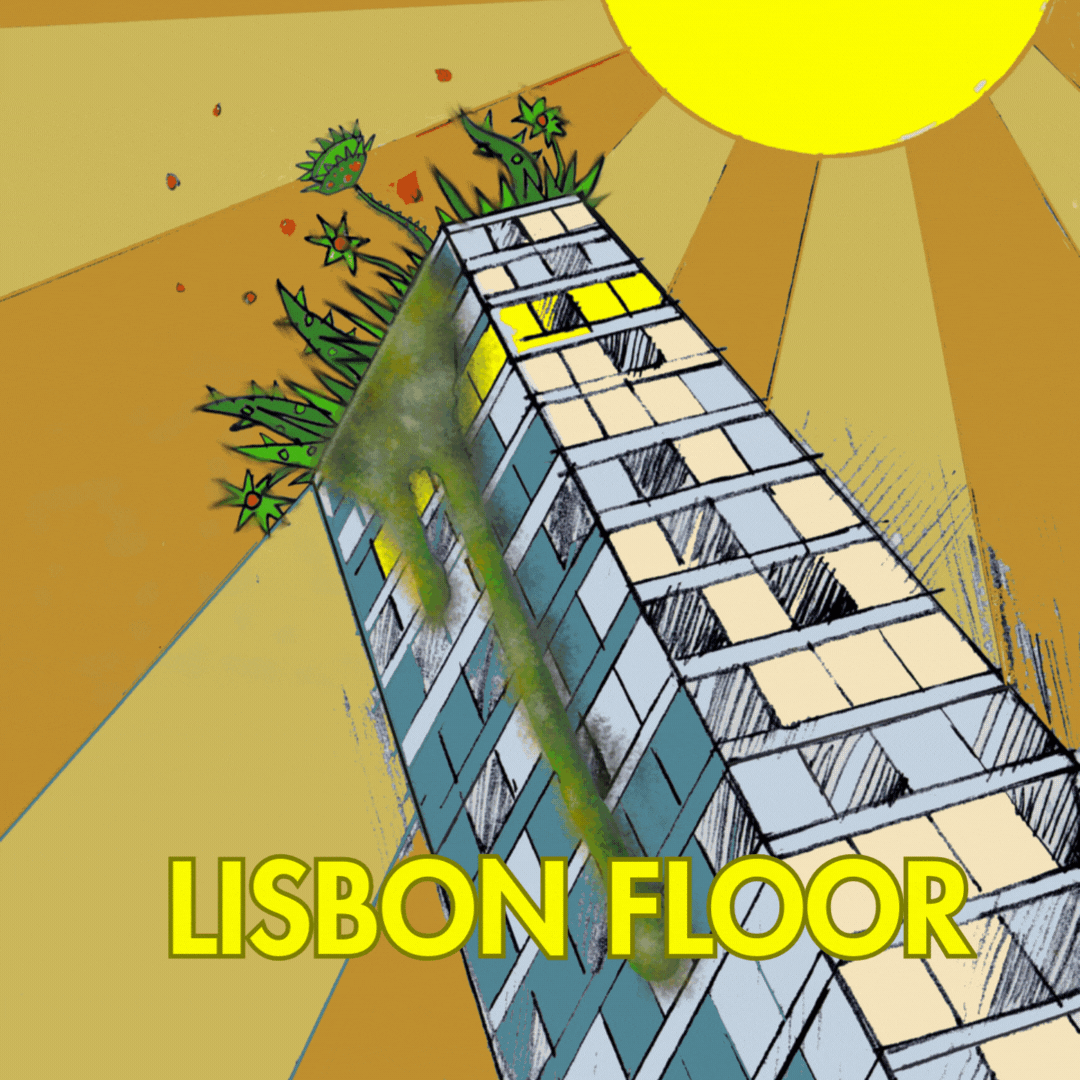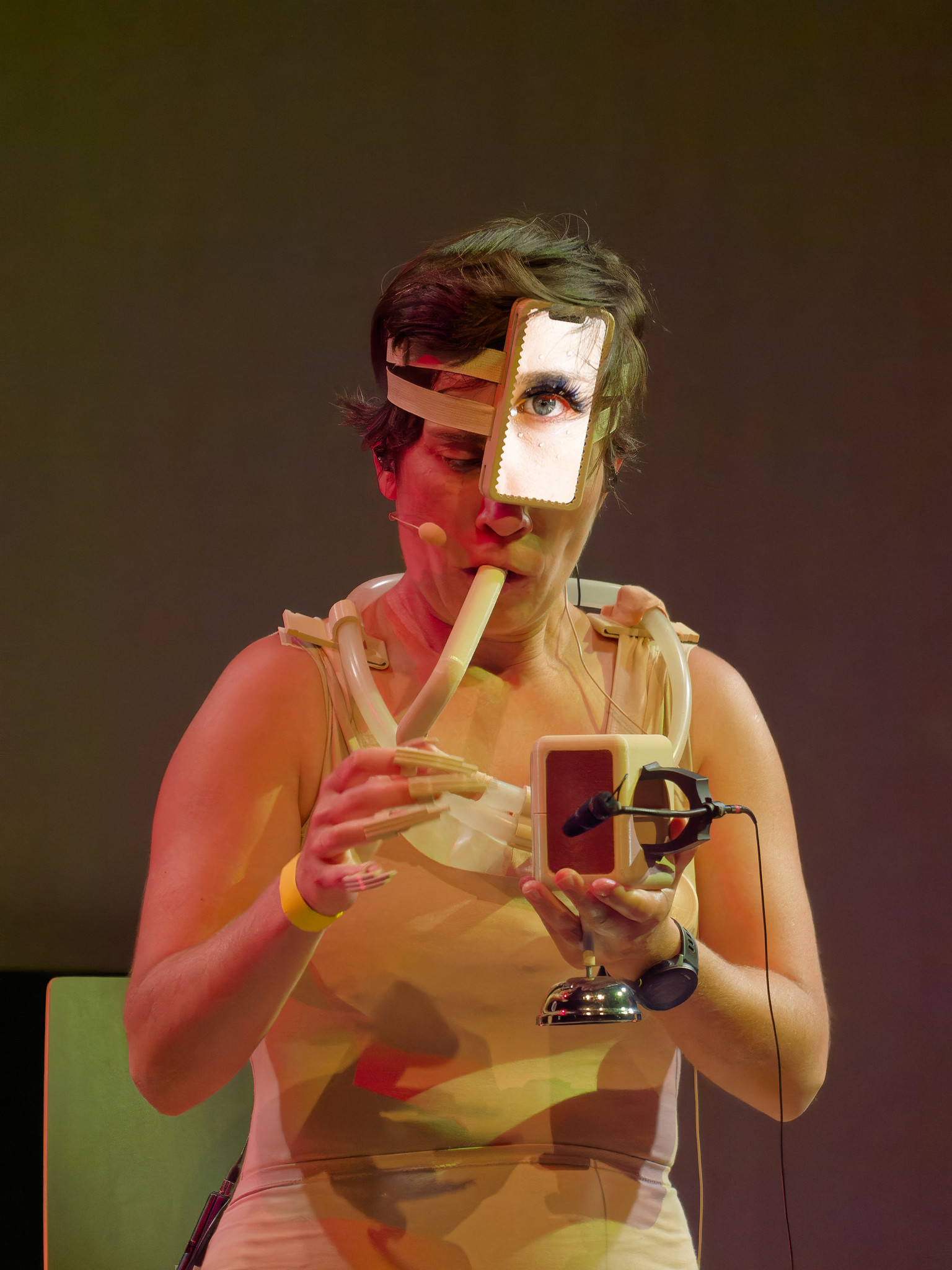
»Ist nix für Frauen«
»Playing the drums is not modest. It’s not quiet. A drum kit takes up space and doesn’t apologize. Essentially, it’s a strong precondition for a ‘It’s not a woman’s thing’ (‘Ist nix für Frauen’)«, percussionist Katharina Ernst told the German newspaper Taz at the dawn of her opening concert for the Heroines of Sound Festival in Berlin.
Since its inception in 2014, Heroines of Sound has actively worked to shift male-dominated narratives in the music scene, significantly enhancing the visibility of FLINTA* (women, lesbians, intersex, non-binary, trans and agender) musicians not only by featuring 350 artists from more than 30 countries over the years, but also by fostering feminist and non-binary movements in music, engaging globally with a network of artists and festivals. Held on July 11-13, the 2024 edition collaborated with local and international organisations like Copenhagen KLANG festival and Zeitgeist Ireland 24, promising a vibrant blend of events and dialogues featuring pioneers and contemporary heroines of music genres ranging from classical contemporary music to progressive pop, with a special focus on voice, electronics and percussion. Artistic Director Bettina Wackernagel, along with co-curators Julia Mihály, Helen Heß, and Sabine Sanio implemented a diverse program of ambitious scope: panels on music and gender-cultural politics, workshops on improvisation with radio bodies and somatic rhythms, a Soundbar and a Filmbar showcasing documentaries and artist interviews that encapsulate the evolution of the festival's themes from 2021 to 2023.
Their show isn’t just about sound
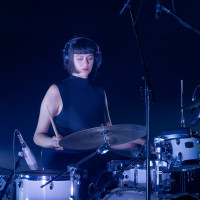
Heroines of Sound honours also early electronic music pioneers, culminating in insightful panel discussions. This year, a dedicated space for video art featured works by Katalin Ladik.
Ernst’s performance Polyrhythmic Focus (2024) sets the tone of the eleventh edition of the festival by demonstrating how a female percussionist can occupy and command space with both energy and structural complexity. Her mesmerising solo performance is followed by Impromptu, the revisited collaboration with Jasmine Guffond, whose intricate electronics and field recordings blends perfectly. The second half of the opening night is taken over by Kompopolex ensemble, a lively trio from Wroclaw with a knack for pushing the boundaries of electroacoustic play. Their show isn’t just about sound – it is a multimedia experience that stretched with agility into performative actions, whisking the audience through pieces that tackled big themes like ecology, capitalist critique, and transhumanism with avant-garde audacity and ironic flair.
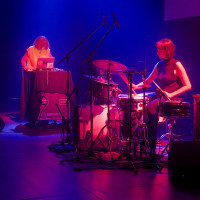
Is it a reference to coral spawning season? Or perhaps to how honeybees communicate through dance movements relative to the sun's position?
Honeybees and posthuman bodies
As we step into the concert hall, a whiff of soap pervades the air, courtesy of the ensemble nonchalantly laundering clothes at the stage's side. Monika Dalach Sayers’ Carbon is the New Black engages with urgent issues such as global pollution and microplastic from synthetic textiles, intertwining traditional ensemble configurations with digital soundscapes, performative gestures, written word, and an array of contemporary media forging a unique, hybrid language. At times, the piece reminds me of the work of hyperpop icon Sophie, with its nods to consumerist pop culture, vivid and rhythmic video montages, bold slogans in large text, and a wry cross-identification between body, identity, and branded products.
With the German premiere of Bubble Honeycomb [Coral], composed by Sophie Søs Meyer and previously presented at Klang festival in Copenhagen, the mood becomes less animated as Meyer embraces a more conceptual approach. As part of a series examining coral and light-sensitive beings, the work is described as both a sonic transposition of their metamorphic changes and a ritualistic homage to honeybees.
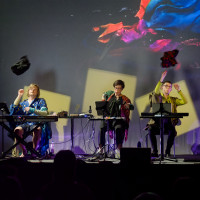
Two performers circle a quartet of cymbals disposed around a table of glasses. Each lifts in succession their left arm before gently bowing the cymbal in front of them, accompanied by an accordion's subtle strains. Silent pauses mark the performance as they mirror each other’s movements, shifting to the next cymbal and repeating the delicate bowing. Occasionally, a hand wiggle prompts a reaction – or none – from the other, suggesting a code of communication or a series of signals, the rules of which remain undisclosed to the audience. Attempting to decode their bodily signals, I try to trace the gestures and possible sonic feedback, though the exact impact remained elusive. Is it a reference to coral spawning season? Or perhaps to how honeybees communicate through dance movements relative to the sun's position?
Meanwhile, I can't shake the feeling – though it might have been more of a fantasy – that the glasses were amplifying certain frequencies of the cymbals’ vibrations, subtly elongating them. As the performers take their seats, the delicate clinking of chopsticks against glasses begin to harmonise with the sonorous timbre of the accordion. Despite its cerebral trajectory, the resultant resonance from the bows, cymbals, glasses, and accordion forms a fragile yet unique beauty, enveloping the concert in an intimate atmosphere. In this setting, the emphasis on process and transformation overshadowed any strict compositional control, enhancing the sense of interrelation among the performers and their instruments. The simultaneous interactions among performers, instruments, and various objects seems to acknowledge their own agency, with the glasses emerging as active participants.
This performance hints at an interconnectedness reflective of object-oriented ontology, culminating in a shared exploration of sound, presence, and the ever-changing relationship between them.
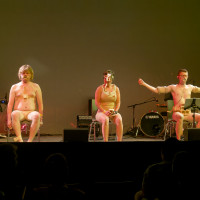
Marta Śniady's Body X Ultra shakes me from the reflective state I am in with a punchy rhythm that dictates the physical actions of the performers. Focused on the intersection between design and art, the piece presents a starkly ironic vision of the posthuman condition – bodies, bereft of souls, merged with machinery whose utility remains ambiguous at best. The disquiet of these hybrid mechanized entities is amplified by a playful rhythm that makes it a mesmerizing spectacle that manages to amuse the public despite the eerie premonition it suggests.
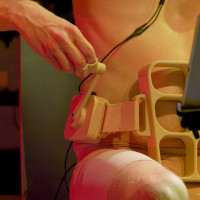
A journey from isolation to intimacy
In the darkness of the changeover, Greta Eacott’s The Hug begins almost unnoticed. Silence fills the space between performers, each positioned against the walls of the hall, each backlit by a stark spotlight that leaves the rest of the room in shadow. The auditory experience shifts from this profound silence one rustle at a time, as the performers slowly step toward each other, their movement animating the soundscape.
When the performers finally embrace, the soundscape feels almost like a frenetic, symphony of touch
The prominent spatiality of the piece unfolds through a crescendo of experimental percussive textures, featuring minute field recordings and contact microphone sounds that squeak, roll, and scratch. As the performers draw nearer to each other, these sounds evolve, shifting from isolated clicks and scrapes to a rich auditory fabric.
Contrary to the expectation of sonorities that evoke the softness of a hug, it is a sound that searches and quivers rather than quietens, reaching its peak at the moment of physical connection. When the performers finally embrace, the soundscape feels almost like a frenetic, symphony of touch. It’s a journey from isolation to intimacy, with the crescendo mirroring the emotional build-up of anticipation and the climax of connection.
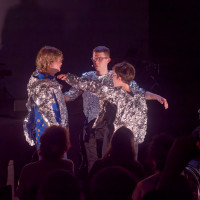
For a moment, when heads rest on each other and the folding of arms and torsos melt into one, the sound dissipates into a silence of a very different flavour than the initial one, filled with the resonance of shared experience and serene abandonment. Here and there, a gentle caress on the shoulder initiates another cascade of tingling noises.
Eacott’s piece zeroes in on tactility, highlighted by the corporeality of the performers dressed in tin foil shirts that, with their crinkling and rustling, add an extra layer of texture and amplify the subtle intensity of their encounter. The simple gesture of hugging transforms into an intense and intricate sensory experience, a contemplation of the seemingly banal that speaks the language often adopted by Eacott, striving to connect with a wide audience rather than delving into esoteric poetics that remain out of reach for most.
This aim does not limit the use of extremely experimental percussive textures and intricate abstract rhythms. The directness and material rawness of Eacott’s sound underscore the physical and contemplative implications of connection and presence, demonstrating how powerfully minimalistic and brief orchestrations can convey complex and profound topics, using avant-garde strategies to amplify, as a relational piezo, minute yet deeply human experiences.
The lineup alternates between contemplative, intimate pieces and vibrant, humorous displays
Space for reflection and empowerment
The evening closes with another commissioned work, Mondo Manifest-o, a nod from Sardinian composer Stellan Veloce to the Italian Mondo film genre. Known for its sensationalist and exploitative lens, often steeped in Eurocentric and racist undertones, the format becomes a tool for Veloce to turn the gaze back onto the Western observer. The piece creates a grotesque mosaic of neoliberal rituals and unrealistic projections of success, revealing the absurdity and hollowness of the social constructs they feed on.
The performance is structured as a series of short poetic songs encapsulating with irony individualistic affirmations that reveal rather delusional forms of entitlement.
Live electronic manipulation of the accordion, along with diatonic harmonicas and melodicas, forms the core of the performance. Equally significant are the performers' corporeal and vocal actions, which use their breathing as a musical gesture and the reading voices as guidance to the performance’s rhythm, bringing it closer to sound poetry than usual in neue musik concerts.
As if in a phony wellness advertisement, Mondo Manifest-o interlaces corporeal presence with abstract ideals and unrealistic expectations, presenting a multi-layered performance that invites the audience to critically examine the Western conceptions of success and self-fulfilment perpetuated by neoliberal ideologies. The brilliance of Veloce’s work lies in its ability to engage, provoke, and amuse, all while delivering a scathing critique on the failure to acknowledge our own privilege and the underlying bleak realities we choose to ignore. Suspended in a virtuality of empty expectations, we are failing to make any real change or, as the closing line of the concert suggests, »edging the revolution.«
I leave the concert hall surprised by how fast the diverse program has passed by, pleasantly surprised by how a rich variety of poetic and stylistic elements have inaugurated the festival. Along the red thread of percussive experimentations and vocal expressions, anchored by a significant electronic presence and punctuated by pop culture references, the lineup alternates between contemplative, intimate pieces and vibrant, humorous displays – each work, though stylistically distinct, delving deeply into social issues and relational dynamics. This nuanced approach enables the audience to engage with complex and significant issues swaying along the lineup between gravity and levity, leaving space for both laughs and concerns, reflection and empowerment.
Heroines of Sound Festival, July 11-13, Berlin.
